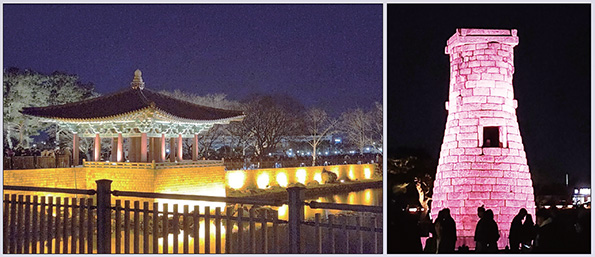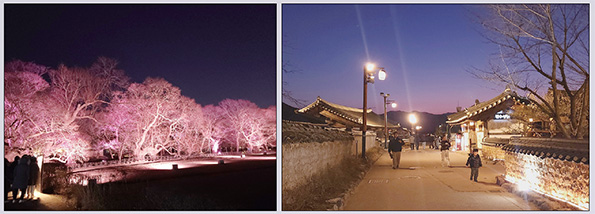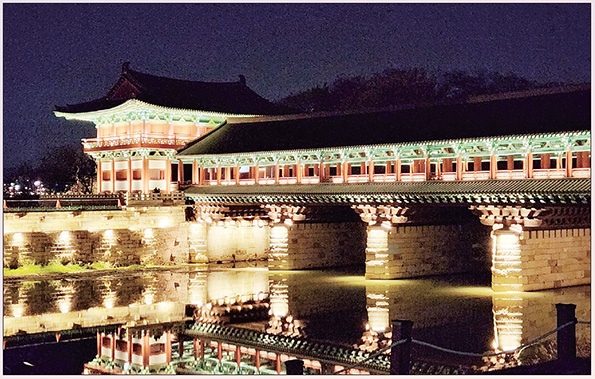The Chungbuk Times > Global > View
Finding the Light of Gyeongju
力 214 龋 惯青老 : 2024.03.11

Gyeongju is a city in southeastern Gyeongsangbuk-do Province, Korea. It is one of the oldest cities in Korea and was the capital of the Silla dynasty, which led the period of the Three Kingdoms (a period of Korean history established by the three countries of Goryeo, Baekje, and Silla) on the Korean Peninsula for about 1,000 years. Therefore, it is called a roofless museum and is well known as a tourist spot where people can encounter cultural heritage sites around every corner. Many historic sites and relics, such as temples and stone Buddha statues that contain the essence of old culture, are scattered throughout the city, giving a glimpse of the culture and art of that time. Among them, this CBT reporter visited five historic attractions in Gyeongju that light up late at night and entertain tourists.
Donggung Palace and Wolji Pond
Donggung is the palace where the crown prince lived, and Wolji is the site of the secondary palace of the Silla palace, where banquets were held when there were national celebratory occasions or when receiving precious guests. After the collapse of Silla, geese (湟) and ducks (溴) migrated here, and the pond became known as Anapji Pond after each Chinese character. However, in the 1980s, earthenware with the inscription Wolji-Moonlit Pond was discovered. Therefore, this palace was identified as a palace called Wolji during the Silla Dynasty, so the name was changed to Donggung Palace and Wolji. In a 1957 excavation, 26 large and small buildings were found around the pond at the site of Imhajeon (a palace building west of Anapji in Silla), which suffered a lot of damage during the Japanese colonial era. Among them, three palaces that appear to be the site of the Silla building, including the one presumed to be Imhajeon, and Wolji have been restored to become representative historical sites of the Silla original site.
If people enter Donggung Palace and Wolji at night, one of the first things people see is the nugak (Korean-style house with two or three floors), where people can enjoy the full view of the surrounding forests and landscapes from the lake and beyond. In the pavilion, there were also building models that were presumed to have been the original version of Donggung Palace and Wolji. In particular, the inner pond was said to have been made by depicting three islands and 12 peak mountains after Sillaʼs reunification of the Three Kingdoms. By design, it is impossible to see the entire pond from a single vantage point, and it is said that this is because the edge of the pond is curved. It was a part that stood out for the foreknowledge of the Silla people, who made the narrow pond feel like the sea. In addition, while walking along the trail, people can enjoy the view of the wall and pavilion lined up and experience the dense pine forest that added to the night scenery.

Cheomseongdae
Cheomseongdae is the oldest observatory in the Orient, which was built during the reign of the 27th Queen Seondeok of Silla. It is about 9m tall and consists of a pedestal, a cylindrical column shaped like an alcohol bottle, and a well-shaped top. The lower part of the window to the southeast is filled with rubble stone, and the upper part is hollow and drilled to the top. In the past, observers said that they placed a ladder on the outside of Cheomseongdae, entered through a window, and then used it to climb to the top to observe the sky. In addition, the stones that make up the Cheomseongdae have their own meanings engraved. The shape of Cheomseongdae, which is round at the top and square at the bottom, depicts the sky and the ground.
The 365 stones that were used to construct Cheomseongdae symbolize the number of days of the year, and the 27 stone steps symbolize the number of days of the lunar month when the 27th Queen Seondeok built Cheomseongdae, and the 29th and 30th steps are combined. The upper and lower 12 levels represent the 12 months and 24 seasons of a year.
Cheomseongdae, which is seen at night, was illuminated alternately with bright red, blue, and green lights. There was a regret that if the subtle lighting had been illuminated, the unique appearance of Cheomseongdae could have been better revealed. However, it was impressive that Cheomseongdae was used to determine the farming period by calculating the movement of the sky and to predict the good luck of the country, which gave a glimpse of Sillaʼs high level of science at the time.
Gyerim Forest
Gyerim is a forest that contains the birth story of Kim Al-ji, the founder of the Kim Dynasty. During the 4th King Talhae of Silla, Hoigong (a person who lets officials return the official seal) heard a chicken clucking in this forest. Upon investigation, it was said that a golden ark was hanging on a branch with a light. The king personally went to the forest and brought the golden ark back to the palace. When the lid was opened, a boy came out of the cage. Therefore, this place was called “Gyerim (彤座)” in the sense of forest (座) where chickens (彤) cry. Gyerim, seen at night, was densely thick with old trees such as zelkova trees that received five-colored lights, and a small brook flowing from the north to the west. If people look around, they can see large tombs with single pine trees growing on them.

Kyochon Village and Historic House of Rich Man Choe
Kyochon Village was the place where Gukhak (national school) was established in the second year of the 31st King Sinmun of Silla, and it was connected to Hyanggyo (Local Confucian School) during the Joseon Dynasty. The name “Kyochon” originated from the meaning of the village where Hyanggyo is located. Also, Historic House of Rich Man Choe is located in Kyochon Village. As a member of a prestigious families who inherited the property of the 9th and 12th Jinsa (a person who passed the Jinsa-examination of the Joseon Dynasty), he was well known for his generosity to neighbors in need.
Woljeonggyo
Woljeonggyo was built during the reign of the 35th King Gyeongdeok of Silla and functioned as a transportation route for Seorabeol. Originally located on the west side of Donggung Palace and Wolji, the bridge took on its present appearance through several restorations and relocations. It is said that during the Silla Dynasty, kings and nobles crossed this bridge and entered Donggung Palace and Wolji. After 10 years of investigation, testimony, and restoration of what was lost during the Joseon Dynasty, the bridge was first restored in 2013, and all restoration was completed in April 2018 by building loft houses on both sides of the bridge. On the second floor of the attic house, there is an exhibition hall where people can see videos of the bridgeʼs restoration process and excavated artifacts.
Although Woljeonggyoʼs structure is simple, it was possible to get a glimpse of the delicate aesthetic sense and architectural skills of the Silla people. The bridgeʼs railing is engraved with Buddhist elements, giving a glimpse of the religious influence of the time. Standing in the center of the stepping stone bridge installed in front of Woljeonggyo Bridge and looking at Woljeonggyo Bridge, people could appreciate the emotional and Korean beauty that glows subtly on the river.

As Gyeongju contains many historical sites, it is considered a tourist destination for studying history, but the CBT reporter had a pleasant day with a night view tour that maximizes the charm of the historic site and was able to leave with good memories in Gyeongju.
By Seo Ah-hyun
tjdkgus666@chungbuk.ac.kr